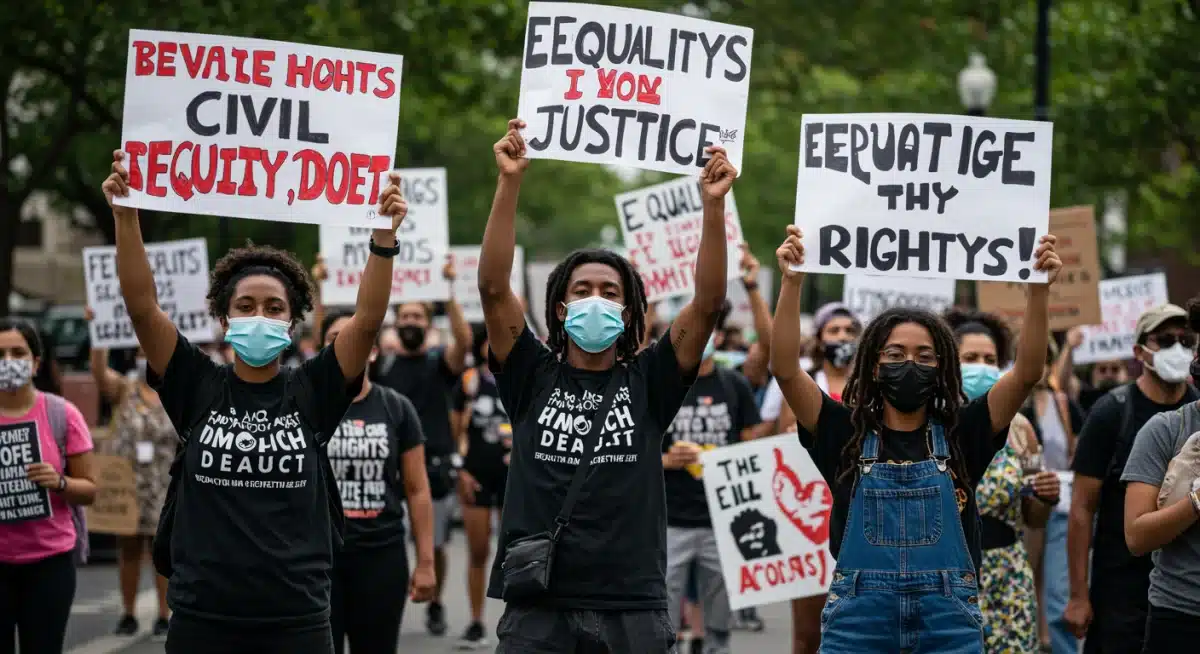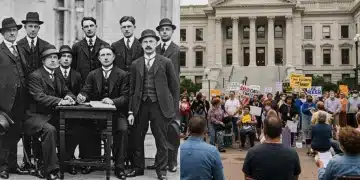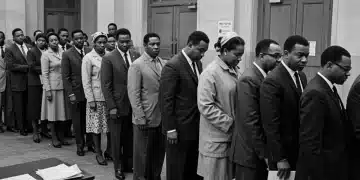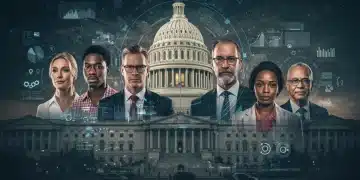Civil Rights Movement Turning Points: Lasting Effects in 2025

The Civil Rights Movement’s pivotal turning points continue to shape US society in 2025, influencing legislative frameworks, fostering social justice initiatives, and challenging systemic inequalities with lasting effects.
As of 2025, the echoes of the Civil Rights Movement Turning Points: Understanding Their Lasting Effects on US Society in 2025 resonate profoundly, continually shaping the nation’s legal landscape, social consciousness, and ongoing pursuit of equality. These historical moments are not just chapters in a textbook; they are living legacies impacting contemporary issues.
The Enduring Legacy of Key Legislation
The legislative achievements born from the Civil Rights Movement remain foundational to modern legal protections against discrimination. Acts like the Civil Rights Act of 1964 and the Voting Rights Act of 1965 directly addressed systemic inequalities, yet their interpretations and applications continue to evolve in 2025.
These landmark laws were crucial in dismantling de jure segregation and granting federal oversight to protect voting rights. Their initial passage marked a dramatic shift in federal policy, explicitly outlawing discrimination based on race, color, religion, sex, or national origin.
Impact on Contemporary Law
The principles enshrined in these acts are consistently referenced in current legal battles concerning civil liberties and human rights. Recent court cases, for example, have examined how these laws apply to emerging forms of discrimination, including those in digital spaces and employment practices. The ongoing dialogue around these statutes underscores their adaptability and enduring relevance.
- Civil Rights Act of 1964: Prohibits discrimination in public accommodations, employment, and federally funded programs.
- Voting Rights Act of 1965: Outlawed discriminatory voting practices, leading to increased minority voter registration and political participation.
- Fair Housing Act of 1968: Prohibited discrimination in housing sales, rentals, and financing.
Educational Desegregation and its Modern Challenges
The Supreme Court’s 1954 decision in Brown v. Board of Education was a monumental turning point, declaring state-sponsored segregation in public schools unconstitutional. While this ruling initiated a long process of desegregation, its promise of equitable education for all remains a work in progress in 2025.
Decades after the initial ruling, many school districts across the US still grapple with de facto segregation, often driven by housing patterns and socio-economic disparities. The focus has shifted from overt legal segregation to addressing more subtle forms of inequality.
Equity in Education Today
As of 2025, discussions around educational equity frequently involve resource allocation, school funding formulas, and the impact of residential segregation on school demographics. Initiatives aimed at promoting diversity and inclusion within educational institutions are directly linked to the goals of the Civil Rights Movement. The push for culturally responsive curricula and equitable access to advanced learning opportunities are contemporary manifestations of this historical struggle.
Furthermore, the debate around affirmative action in college admissions, though evolving, continues to reflect the core tensions identified during the movement: how to address historical disadvantages and foster a diverse learning environment. These discussions highlight the complex and multifaceted nature of achieving true educational parity.
The Evolution of Voting Rights and Political Power
The Voting Rights Act of 1965 (VRA) dramatically reshaped the American political landscape by eliminating discriminatory barriers to voting. This pivotal legislation led to a significant increase in African American voter registration and the election of minority representatives at all levels of government. However, the VRA’s power has faced challenges, particularly in the last decade.
The Supreme Court’s 2013 decision in Shelby County v. Holder struck down a key provision of the VRA, eliminating the requirement for certain jurisdictions with a history of discrimination to obtain federal preclearance before changing their voting laws. This ruling has opened the door for new voting restrictions to be implemented in various states.
Current Voting Rights Landscape in 2025
In 2025, debates surrounding voter access are as prominent as ever. New state laws concerning voter ID requirements, limitations on early voting, and purges of voter rolls are under intense scrutiny. Advocates argue these measures disproportionately affect minority voters, echoing the very concerns the VRA was designed to address. The fight for robust and equitable voting rights continues to be a central theme in the ongoing pursuit of civil rights.
The political power gained by minority communities since the VRA’s passage is undeniable, with increased representation in Congress and state legislatures. Yet, efforts to expand or restrict voting access demonstrate that the battle for full political enfranchisement is far from over, making it a critical aspect of Civil Rights Movement Turning Points: Understanding Their Lasting Effects on US Society in 2025.

Social Justice Movements and Activism in the 21st Century
The strategies and philosophies of the Civil Rights Movement laid the groundwork for subsequent social justice movements. From the women’s rights movement to LGBTQ+ rights and disability rights, the tactics of nonviolent protest, civil disobedience, and legal advocacy proved highly effective and continue to be employed by activists today.
The Black Lives Matter movement, which gained significant momentum in the 2010s and continues its advocacy in 2025, directly draws inspiration from the Civil Rights Movement. It focuses on systemic racism and police brutality, highlighting ongoing racial disparities in the justice system.
Modern Activism’s Roots
Contemporary activism leverages digital platforms and global connectivity, but its core principles—demanding equal rights and challenging oppression—are deeply rooted in the Civil Rights era. The emphasis on community organizing, public awareness campaigns, and direct action reflects a continuing commitment to the ideals championed by leaders like Martin Luther King Jr.
- Nonviolent Protest: The enduring power of peaceful demonstrations to raise awareness and pressure for change.
- Legal Advocacy: Utilizing the court system to challenge discriminatory practices and expand civil liberties.
- Community Organizing: Building grassroots support and empowering local communities to advocate for their rights.
Economic Disparities and the Fight for Equity
While the Civil Rights Movement achieved significant legal victories, economic disparities persist, highlighting an area where the movement’s goals remain unfulfilled. The fight for economic justice was an integral, though often overshadowed, component of Dr. King’s vision, culminating in initiatives like the Poor People’s Campaign.
In 2025, data consistently reveals significant wealth and income gaps along racial lines. These disparities are often attributed to historical disadvantages, including discriminatory housing policies, unequal access to education, and systemic biases in employment and lending practices.
Addressing Economic Inequality
Current efforts to address economic inequality are directly informed by the historical context of the Civil Rights Movement. Policies promoting equitable access to capital, fair employment practices, and affordable housing are seen as crucial steps toward achieving true equality. Debates around reparations for historical injustices, while highly contentious, are also part of this broader conversation, seeking to address the long-term economic consequences of slavery and segregation.
The intersection of race and class remains a critical area of focus for social justice advocates, underscoring that legal equality alone is insufficient without corresponding economic opportunity. This ongoing struggle for financial equity is a powerful testament to the lasting effects of Civil Rights Movement Turning Points: Understanding Their Lasting Effects on US Society in 2025.
Cultural Impact and Shifting Narratives
Beyond legislation and direct activism, the Civil Rights Movement profoundly reshaped American culture and national identity. It forced a critical examination of the nation’s founding ideals versus its historical realities, leading to a more inclusive, albeit still imperfect, understanding of American history.
In 2025, cultural institutions, educational curricula, and media representations increasingly reflect a more diverse and nuanced perspective on race and identity. This shift is a direct outcome of the movement’s challenge to dominant narratives and its insistence on acknowledging the experiences and contributions of marginalized communities.
Media and Representation
The increased visibility of diverse voices in media, arts, and literature is a clear indicator of this cultural transformation. While progress has been made, discussions around authentic representation, combating stereotypes, and ensuring equitable opportunities in creative industries continue. The demand for stories that accurately reflect the complexity of American society is a direct legacy of the Civil Rights Movement’s push for recognition and dignity.
Public discourse around racial justice, systemic oppression, and intersectionality is more prevalent than ever. This elevated awareness, while sometimes leading to uncomfortable conversations, is essential for continued societal growth and the realization of a truly inclusive nation. The cultural ripple effects continue to redefine what it means to be American.
| Key Point | Brief Description |
|---|---|
| Legislative Foundation | Civil Rights Act of 1964 and Voting Rights Act of 1965 continue to shape legal protections and provoke ongoing debates on their application. |
| Educational Equity | Brown v. Board of Education’s legacy still influences discussions on de facto segregation, funding, and diverse curricula in 2025. |
| Voting Rights Challenges | Despite the VRA, voter access remains a contentious issue in 2025, with ongoing debates over new state-level restrictions. |
| Modern Activism | Contemporary social justice movements, like Black Lives Matter, draw heavily on the strategies and principles of the Civil Rights era. |
Frequently Asked Questions About Civil Rights Legacy
The Civil Rights Act of 1964 continues to serve as the bedrock for anti-discrimination laws in employment, public accommodations, and federally funded programs. In 2025, its principles are still applied to new forms of discrimination, including those in digital spaces, ensuring its enduring relevance in modern legal challenges and protections.
In 2025, Brown v. Board of Education continues to influence efforts toward educational equity, though de facto segregation persists due to housing patterns. The ruling underpins discussions on school funding, resource allocation, and the implementation of diverse, inclusive curricula to ensure all students receive an equitable education.
The Voting Rights Act of 1965 faces significant challenges in 2025, particularly after the 2013 Shelby County v. Holder decision weakened its federal oversight. New state-level voting restrictions, such as voter ID laws and purges, are under scrutiny for their potential to disproportionately impact minority voters, sparking ongoing legal and political battles.
Modern social justice movements, including Black Lives Matter, draw heavily on the strategies and foundational principles of the Civil Rights Movement. They employ nonviolent protest, legal advocacy, and community organizing to address contemporary issues like systemic racism and police brutality, demonstrating a direct lineage of activism for equality.
Yes, economic disparities in 2025 are still profoundly affected by the Civil Rights Movement’s legacy, particularly in areas where its economic justice goals remain unfulfilled. Historical disadvantages, discriminatory housing, and unequal access to resources continue to contribute to wealth and income gaps, fueling ongoing efforts for economic equity and reparations.
Impact and Implications
The ongoing relevance of Civil Rights Movement Turning Points: Understanding Their Lasting Effects on US Society in 2025 underscores that the struggle for equality is a continuous process. As of this year, current events, legal challenges, and social movements consistently demonstrate that the ideals championed decades ago are still being fought for and refined. The nation’s ability to address contemporary issues like systemic racism, voting rights, and economic disparities hinges on a clear understanding of these historical foundations and a commitment to their full realization. Watch for continued legislative debates, judicial interpretations, and grassroots activism shaping the path forward.





